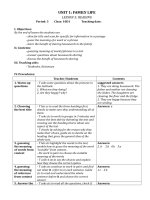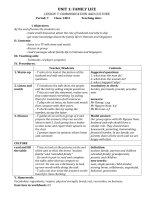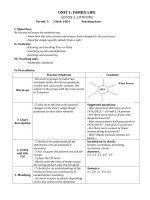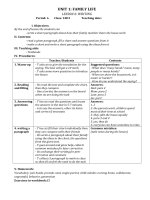Giáo án Tiếng anh thí điểm 7
Bạn đang xem bản rút gọn của tài liệu. Xem và tải ngay bản đầy đủ của tài liệu tại đây (160.29 KB, 13 trang )
<span class='text_page_counter'>(1)</span><div class='page_container' data-page=1>
<b>Date of preparing: Oct 21st<sub> 2017 Period: 35</sub></b>
<b>UNIT 5: VIETNAMESE FOOD AND DRINK</b>
<b>LESSON 3 : A CLOSER LOOK 2 (P. 51 - 52)</b>
<b>A. OBJECTIVES: </b>
- By the end of the lesson, students will be able to use and practice “a/ an, some
and any” to talk about quantity; “How much and How many” to ask about
quantity; distinguish countable nouns and uncountable nouns
+ Vocabulary:
+ Grammar: - a/ an, some and any to talk about quantity
- How much and How many to ask about quantity
- distinguish countable nouns and uncountable nouns
- Skills: Practice and develop speaking, listening and writing skills .
- Political thought and moral sense: educate students to know more about foods
and drinks in Viet Nam and educate them to love the subject more.
- Competence: Ss can listen comprehension and speak English more fluently.
<b>B. TEACHING AIDS: </b>
- Textbook, teacher’s book, lesson plan, board, chalks and the projector.
<b>C. METHODS: </b>
Brainstorming, Grids, Gap-fill, Game, Pair-working.
<b>D. PROCEDURE: </b>
<b>I . Organization(1’) </b>
- Greeting
Class Date of teaching Absent students
7A
7B
<b>I .Oganization: </b>
<b>II. Revision / warm er. (4’)</b>
<i><b>* Brainstorming.</b></i>
- T draws the net on the board.
- T gives the instructions: write down as many foods and drinks as possible.
- T models the first one.
meat
- T checks Ss' understanding.
- Ss think and prepare in about 1 minute.
</div>
<span class='text_page_counter'>(2)</span><div class='page_container' data-page=2>
- T divides the class into 2 groups. T gives the name -> checks
- One by one student from each group comes to the board and writes one answer.
- T corrects then praises the winner.
<i><b>+ Possible answers : </b></i>
vegetables, bread, meat, beef, pepper, pork, rice, eggs, water, juice, lemon juice,
<i><b>orange juice, coffee ... </b></i>
<b>III. New lesson:</b>
<i><b>Step1: Activity 1: Countable and uncountable nouns. ( 12’)</b></i>
<i><b>* Grammar Box.</b><b> </b></i>
<i>- T asks Ss to study the “Grammar Box p. 51”. T draws Ss’ attention to the </i>
difference between countable and uncountable nouns and the use of measurement
<i>phrases, by analysing the examples in the “Grammar Box p. 51”. </i>
- T asks Ss to gives some more examples. T also reminds Ss that they should use a
good dictionary to check if a noun is countable or uncountable.
<i>+ Notes: For uncountable nouns we can use phrases like a bottle of, a piece of, a </i>
<i>bar of, a glass of, a kilo of, and a bag of, etc.</i>
<i><b>* Grids (Part 1 p. 51)</b></i>
- T shows the pictures in part 1 p. 51 then runs through.
- T draws the table on the board then runs through.
- T asks Ss to put the nouns into the right columns.
- T models one and checks Ss’ understanding.
<b>Countable</b> <b>Uncountable</b>
banana bread
- Ss do individually then they compare with their partners.
- T gets Ss’ answers then corrects.
<i><b>+ Answer key:</b></i>
<b>Countable</b> <b>Uncountable</b>
banana
apple
bread pork
beef turmeric
pepper spinach
<i><b>Step2: Activity 2: A/ An/ Some/ Any (14’)</b></i>
<i><b>* Grammar Box.</b><b> </b></i>
<i>- T asks Ss to study the “Grammar Box p. 52”. T draws Ss’ attention to the use of </i>
<i>“ a, an, some, and any” by analysing the structures and examples in the </i>
<i>“Grammar Box </i>
</div>
<span class='text_page_counter'>(3)</span><div class='page_container' data-page=3>
- T asks Ss to gives some more examples. T also reminds Ss of the special use of
some in an offer or a request.
<i><b>* Game: Give me an egg ( Part 2 p. 52)</b></i>
- T demonstrates the game to the class first -> Checks Ss’ understanding.
- T asks Ss to work in groups. One team says words related to food or drink. The
other teams adds some or a / an.
+ Example:
Team 1: egg
Team 2: an egg
Team 1: flour
Team 2: some flour
- T controls and corrects.
<i><b>* Gap-fill (Part 3- p. 52)</b></i>
- T shows the poster that has the contents of part 3 p. 52 then T runs through.
- T gives the instructions: Fill the blanks with a/ an, some, or any in the following
conversation.
- T models.
1. any
- T checks Ss’ understanding
- Ss do individually then compare with their partners.
- T asks one by one student comes to the board and writes the answers.
- T corrects.
<i><b>+ Answer key: </b></i>
1. any 5. a
2. some 6. an
3. some
4. any
<i><b>Step 3: Activity 3: How many? How much? (12’)</b></i>
<i><b>* Grammar Box.</b><b> </b></i>
<i>- T asks Ss to study the “Grammar Box p. 52”. T helps Ss distinguish the use of “ </i>
<i>How many? and How much?” by analysing the instruction and examples in the </i>
Grammar Box. T also asks some more able Ss to give some more examples.
<i><b>* Gap-fill ( Part 4 p. 52)</b></i>
- T shows the poster then T runs through.
</div>
<span class='text_page_counter'>(4)</span><div class='page_container' data-page=4>
3. ... bananas are there on the tables?
4. ... sandwiches are there in your bag?
5. ... water is there in the bottles?
- T gives the instructions: Fill each blank with “How many” or “ How much”
- T models one.
1. How many
- T checks Ss’ understanding.
- Ss do individually then compare.
- T gets Ss’ answers then corrects.
<i><b>+ Answer key:</b></i>
1. How many
2. How much
3. How many
4. How many
5. How much
<i><b>* Pair-working ( Part 5 p. 52)</b></i>
- T shows the poster that has the contents of part 5 p. 52 then T runs through.
- T gives the instructions: You work in pairs, use the suggested words to make
questions with “How many/ How much” to interview your partner.
- T gives one example:
milk/ drink/ every morning
How much milk do you drink every morning?
- T checks Ss’ understanding
- Ss work in pairs.
- T goes around to see and helps Ss.
- T call some pairs to act out.
- T asks other students to give comments then corrects.
<i><b>+ Answer key: </b></i>
1. How much water do you drink every morning?
2. How much rice do you eat for dinner?
3. How many vegetables do you eat every day?
4. How many apples do you eat every day?
<b>IV. Summary(1’) </b>
- T asks Ss to repeat the main contents of the lesson.
<b>V. Homework(1’)</b>
</div>
<span class='text_page_counter'>(5)</span><div class='page_container' data-page=5>
- Do the exercises: 4 and 5, 6, 7 in part B p. 37, 38
- Prepare the new lesson: Unit 5: Lesson 4: Communication.
<b>*.EVALUATION: </b>
</div>
<span class='text_page_counter'>(6)</span><div class='page_container' data-page=6>
<b>LESSON 4 : COMMUNICATION (P. 53)</b>
<b>A.OBJECTIVES: </b>
- By the end of the lesson, students will be able to listen and talk about different
types of Vietnamese food, drink, and recipes.
+ Vocabulary: sticky rice, sauce, sausage, yoghurt, tuna, ham.
+ Grammar:
- Skills: practice and develop listening and speaking skill.
- Political thought and moral sense: educate students have healthy foods and drinks
and they will be interested in learning English more.
- Competence: Ss can develop and use skills fluently
<b>B.TEACHING AIDS: </b>
- Textbook, teacher’s book, lesson plan, board, chalks, projector.
<b>C . METHODS: </b>
Chatting, matching, open-prediction, listen and check, grids and reporting.
<b>II. Revision: </b>
<b>D. PROCEDURE: </b>
<b>I . Organization(1’) </b>
- Greeting
Class Date of teaching Absent students
7A
7B
<i><b>* 15 minute - test. </b></i>
<i><b>1. Choose the best answer for each following sentence (5,0 pts)</b></i>
a. I haven’t got ( some/ no/ any ) bread left for breakfast.
b. She’s got ( some/ a lot / any ) nice photos of our classmates.
c. Have you got ( any/ a lot/ a ) butter in your fridge?
d. This morning, I didn’t have (some/ no/ a) cup of coffee as usual.
e. There (isn’t any/ isn’t some/ aren’t any) yoghurt in this carton.
<i><b>2. Write the answers for these questions (5,0 pts)</b></i>
1. How many meals do you often have a day?
2. What do you have for breakfast?
3. What time do you usually have breakfast?
4. What is your favourite food? When do you often eat it?
5. What is your favourite drink? When do you often drink it?
<i><b>+ Answer key and point. - Each right answer Ss get one point.</b></i>
1. a. any d. a
</div>
<span class='text_page_counter'>(7)</span><div class='page_container' data-page=7>
c. any
2. Ss’ answers
<i><b>+ Answer key: </b></i>
<b>III. New lesson:</b>
<i><b>Step1: Activity 1: Part 1 p. 53 (10’)</b></i>
<i><b>* Vocabulary:</b></i>
- sticky rice (n): xôi (picture)
- sauce (n): nước sốt (example)
- sausage (n): xúc xích (picture)
- yoghurt (n): sữa chua (picture)
- tuna (n): cá ngừ (picture)
- ham (n): thịt giăm bông (transaltion)
<i><b> + Checking vocabulary: Matching.</b></i>
<i><b>* Open prediction ( part 1 p. 53)</b></i>
+ Sets the scene:
- T shows the picture of a celebrity chef, Austin Nguyen then asks Ss some
questions.
Who is he ? - Austin Nguyen
What does he do? - He’s a celebrity chef
- T says: Now you are going to listen to a celebrity chef, Austin Nguyen talking
about his favourite food.
- T asks Ss to look at the picture of the chef and predict which food or dishes in
<i><b>Extra vocabulary he might like.</b></i>
- T models.
<b> - sticky rice </b>
- T checks Ss’ understanding.
- Ss predict individually then compare
- T gets Ss’ predictions.
<i><b>* Listen and check</b></i>
- T asks Ss to listen and check their predictions.
- T play the recording twice.
- Ss listen and check their predictions.
- Ss do individually then compare.
- T gets Ss’ answers then corrects.
<i><b>+ Answer key: </b></i>
</div>
<span class='text_page_counter'>(8)</span><div class='page_container' data-page=8>
<i><b>Step 2: Activity 2: Part 2- 3 p. 53 (10’)</b></i>
<i><b>* Grids</b></i>
- T shows the poster then runs through.
<b> Questions</b> <b>Your</b>
<b>answers</b>
<b>Student</b>
<b>1</b>
<b>Student</b>
<b>2</b>
<b>Student</b>
<b>3</b>
1. What’s your favourite food?
2. How does it taste?
3. What’s your favourite
drink?
4. When do you often drink it?
5. What foreign food/ drink do
you like?
6. What new food do you want
to try?
7. What food do you hate?
8. What food can you cook?
- T asks Ss to answer the questions individually then they compare with their
partners to find out what they have in common with their partners.
- Ss do individually then compare with their partners.
- When Ss finish, T asks them to move around and ask different classmates every
question in the table ( avoiding those whom they have shared their answers with in
1). T reminds Ss to write the names of the people they interview and note the
answers in the table.
- Ss do
- T controls.
- When Ss have finished the interview, T may have Ss practise reporting the results
of their interview in pairs or in groups ( including the information about
themselves).
<i><b>Step3: Activity 3: Part 4 p. 53 (7’) </b></i>
<i><b>* Reporting</b></i>
- T calls on some Ss to report the results of their interviews before the whole class.
- After each Ss has finished his/ her report, T invites some comments from other Ss
-> T makes comments and corrects the common errors.
<b>IV. Summary (1’)</b>
</div>
<span class='text_page_counter'>(9)</span><div class='page_container' data-page=9>
<b>V. Homework (1’)</b>
- Learn by heart the vocabulary and practice reporting at home.
- Do all exercises 1, 2 in part C in the workbook p. 39.
- Prepare the new lesson: Unit 5: Lesson 5: Skills 1
<b>*. EVALUATION: </b>
...
...
<b>---@---Date of preparing: Oct 27th<sub> 2017 Period: 37 </sub></b>
<b>UNIT 5: VIETNAMESE FOOD AND DRINK </b>
</div>
<span class='text_page_counter'>(10)</span><div class='page_container' data-page=10>
- By the end of the lesson, students will be able to read for specific information
<i>about pho, a popular food in Viet Nam and talk about different types of </i>
Vietnamese food, drink, and recipes.
+ Vocabulary: slice, bone, broth, stew, boneless.
- Skills: develop and practice reading and speaking skills.
- Political thought and moral sense: educate students know more about Vietnamese
traditional food and drink and they will be interested in learning English more.
- Competence: Ss can introduce foreigner about different types of Vietnamese food
and drink
<b>B. TEACHING AIDS:</b>
- Textbook , teacher’s book , lesson plan , board , chalks, pictures and posters.
<b>C . METHODS: </b>
Chatting, pre-questions, read and check, guess the meanings of the words,
comprehension questions, gap - fill and pair- working.
<b>D. PROCEDURE: </b>
<b>I . Organization(1’) </b>
- Greeting
Class Date of teaching Absent students
7A
7B
<b>II. Revision / Warmer: </b>
<i><b>*Chatting: (4’)</b></i>
- T asks Ss some questions
- Have you ever had Pho?
- When do you usually have it?
- Do you like to have it? Why? / Why not?
- Ss answer freely.
<b>III.New lesson : </b>
<i><b>Step 1: Pre – reading12’) </b></i>
<i><b>* Pre-questions</b></i>
+ Set the scene: T shows the picture and asks Ss questions.
- What dish do you think it is? - Pho
</div>
<span class='text_page_counter'>(11)</span><div class='page_container' data-page=11>
- T says: “ You are going to read a text about Pho.
- T shows out three questions then runs through.
<i> - Which place is famous for Pho ?</i>
- What are the ingredients for it ?
- T asks Ss to predict the answers for these questions.
- T checks Ss’ understanding.
- Ss work in pairs to answer the questions.
- T gets Ss’ predictions.
<i><b>Step 2: While-reading. (18’)</b></i>
<i><b>* Activity 1:Read and check</b></i>
- T asks Ss to scan the text then answer the questions.
- Ss do individually then compare with their partners.
- T gets Ss’ answers then corrects.
<i><b>+ Answer key:</b></i>
1. Ha Noi
2. rice, bones of cows, beef, chicken bones, chicken meat
<i><b>*Activity 2: Guess the meaning of the words ( Part 1 p. 54 )</b></i>
- T shows the words and runs through.
stewing, bones, broth, boneless, slice
- T asks Ss scan the passage to find the above words and underline.
- T asks Ss to work out the meanings of these words by using the context of the
passage. If they are weak, T may asks for translation to check if they understand.
<i><b>+ Answer key: </b></i>
- variety (n): nhiều
- pot (n): nồi, soong
- broth (n): nước xuýt, canh
- stew (v): hầm
- boneless (adj): không xương
- bone (n): xương
<i><b>* Activity 3: Comprehension questions</b></i>
- T shows the questions then runs through.
<i>1. When can we enjoy pho?</i>
2. What are the noodles made from?
<i>3. How is the broth for pho bo ( beef noodles soup) and pho ga ( chicken </i>
noodle soup ) made?
<i>4. How is the chicken meat served with pho ga ?</i>
- T gives the instructions: Read again the text then answer the questions.
- T checks Ss’ understanding.
</div>
<span class='text_page_counter'>(12)</span><div class='page_container' data-page=12>
<i><b>+ Answer key:</b></i>
<i> 1. We can enjoy pho for all kind of meals during a day, from breakfast to dinner, </i>
and even for a late night snack.
2. They are made from the best variety of rice.
3. The broth for pho bo is made by stewing the bones of cows for a long time in
a large pot.
4. It is boneless and cut into thin slices.
<i><b>Step 3: Post-reading.( Speaking)(8’)</b></i>
<i><b>* Pair - working ( Part 3P. 54 )</b></i>
<i><b>- T shows the list of ingredients and runs through. </b></i>
- T asks Ss to work in pairs to asks and answer questions about the ingredients. (T
reminds the use of “ a/ an, some/ any; How much/ How many)
- T models.
A: I want to cook an omelet. What ingredients do I need?
B: You need ...
A: How much/ How many...?
- T checks Ss’ understanding.
- Ss work in pairs.
- T may go around to help weaker Ss.
- After Ss finish, T calls on some pairs to practise in front of the class.
- T asks other Ss to give comments, then T gives her comments.
<i><b>* Gap - fill ( Part 4 p. 54 - 55 ).</b></i>
- T shows the pictures and the phrases in part 4 p. 54 - 55 then runs through.
- T asks Ss to use the phrases to complete the instructions.
- T models one. 1. d.
- Ss do individually then compare with their partners.
- T gets Ss’ answers then corrects.
<i><b>+ Answer key:</b></i>
1- d; 2 - e; 3 - a; 4 - b; 5 - c
- T calls on some students to practise giving instructions in front of the class on
how to make an omelet.
- T asks other Ss to give comments.
- T gives her comments and may give marks.
<b>IV. Summary(1’)</b>
- T asks Ss to repeat the main contents of the lesson.
<b>V. Homework(1’) </b>
- Learn by heart all the vocabulary.
- Read the passage fluently then translate into Vietnamese.
- Prepare part 5 at home.
</div>
<span class='text_page_counter'>(13)</span><div class='page_container' data-page=13>
- Prepare the new lesson: Unit 5: Lesson 6: Skills 2.
</div>
<!--links-->









